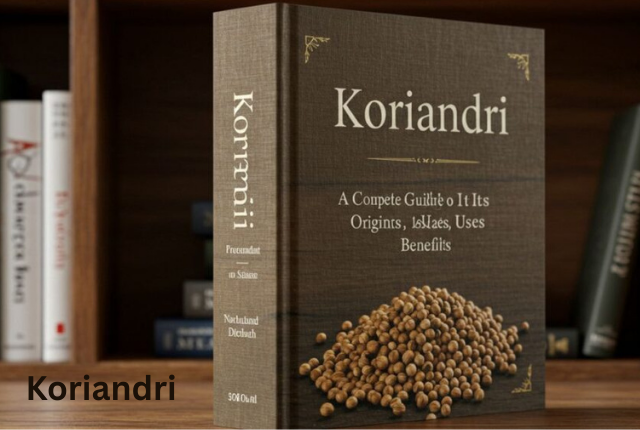Koriandri The Health and Tasting Multipurpose herb

You would always wonder about that herb, which adds a fresh, citrusy flavour to your most favourite dishes and which has a bag full of health benefits to his/her credit. The solution is to add that healthy ingredient the coriander (or in most cultures simply called cilantro). Koriandri, a Hellenic term commonly used globally, is green soft part and seeds of the Coriandrum sativum plant. The paper introduces koriandri’s kitchen flexibility, benefits over other foods, and how to incorporate koriandri consumption into daily life. You will find practical recipes, hygienic suggestions, ideas based on investigations for advancing the meal’s position for amateurs or professionals.
Table of contents
What is Koriandri?
The Origins and Varieties of Koriandri
The Georgian name of coriander, i.e. history Koriandri is 7000 years old. It was first grown in the Mediterranean Basin but now cultivated globally, with India producing over 500,000 tons, says FAO statistics. The plant yields both the fresh leaves (the fresh leaves are sometimes known as cilantro in the United States), and seeds (coriander spice), which have uniquely different flavors. Leaves have light delicate and citrusy flavour and seeds are warm and nutty to grind. This leaves growers with the freedom of choice in terms of requirements, such as there are varieties like Moroccan (seeds) and Santo (leaves). This ambivalence gives koriandri universality in Indian curries and Mexican salsas, achieving status as a multipurpose kitchen ingredient.
Naming Social Convention
Koriandri is figurative and it applies across a number of societies. It is vital to Georgian cuisine using it in Kharcho soup and Thailand cuisine using it in green curry dishes. A Statista report indicated that in 2023, coriander seed’s world trading capacity amounted to 322 million, analyzing its demand globally. Koriandri adapts to any weather, so people interested in ethnobotany should plant it in their home gardens. That it can be classic medicine solution, shown in 2023 NCBI article, indicates it’s more than just food, addressing indigestion. The encouragement to experiment with such cultural richness also resolves the pain point of boring menus.
Health Benefits of Koriandri
Nutritional Profile and Key Compounds
Koriandri is highly nutritious where fresh Koriandri leaves contain 92 percent water, vitamin K, C and A and minerals iron, and potassium. The leaves contain 23 calories and 3.7 grams of fibre content per 100 grams, according to USDA. Seeds contain more antioxidants – linalool and pinene, a substance that neutralizes free radicals. A November 2022 article Healthline describes how the compounds aid in inflammation and immune-related support. In cases of insufficient supply of some nutrients like vitamin K found in koriandri that helps our bodies clot blood and form bones, our health conscious readers may substitute koriandri. This is why it is a reference for professionals enduring stressful lifestyles, whose food ought to be complemented by it.
Digestive and metabolic Support
Koriandri possesses great qualities of digestive aids also. The leaves initiate bowel regularity by stimulating fiber, and the seeds boost enzyme generation to help prevent bloating effectively. Ibs: In a 2019 study published in the journal of ethnopharmacology, an extract of coriander reduced the symptoms of IBS by fifty percent in its participants. Koriandri reduces blood sugar levels in diabetic patients; a 2021 Pharmeasy article indicated it helped normalize blood sugar levels. Handy tip: For an upset stomach, place one teaspoon of seed tea into the water and leave it to steep up to 10 minutes. The shortcomings of this solution include uncomfortable feelings after meals, eliminated naturally without additives using principles of the naturalistic approach.
Anti-inflammatory and Antioxidant activity
Antioxidants in Koriandri help lower reduced oxidative stress, effectively preventing one factor causing chronic diseases. A 2023 article published by PMC has revealed that it is heart friendly as it reduces cholesterol content and blood pressure. Essential oils have the potential of killing off bacteria such as Salmonella (in seeds). According to a 2024 MarketersFinder article, topical mixtures heal the skin and help reduce acne. Practicing hobbies, enthusiasts do not need more than 15 minutes per week and leaves plus yogurt to create a face mask. These advantages give a solid support to the readers to overcome inflammation themselves.
Risk and other Considerations
Although it is beneficial, koriandri has some disadvantages in that it may result in allergies and hay fever amongst other cheap products. This should be used sparingly on women during pregnancy because it is an emmenagogue compound, as demonstrated in an article by 2025 USA Today. Start with low dosage when you are a new user. This fair play is enticing to the critical consideration of the readers and less anxiety on the use of natural medicines.
Culinary Uses of Koriandri
Leaves Mint in villainous Cookery
Fresh koriandri leaves add color to salads and soups and also salsa. They form a major constituent in guacamole in Mexican cuisine and bring spice in them. According to a 2024 MarketersFinder article it is advisable to chop the leaves into small pieces to enable oils to give out, and also produce flavor. Add to stir fry or tacos towards end so as not to get mushy. This sort of versatility is a relief to mindless eating and cooking turns surrealistic.
Seeds as a staple spice
Seeds Koriandri Seeds warm curries rubs The two processes presented above can be altered since the seeds can be toasted and the ground ones ground more thoroughly based on the requirement identified in a 2023 Slofoodgroup blog. It is important in the Indian garam masala and it blends well with cumin and cardamom. Professionals may experiment with blends of pickling spices, and may even add seeds to brines to give something crunchy. This takes home cooking to a different level and makes them not too challenging.
Innovative Recipes with Koriandri
The procedure of preparing koriandri chutney: The salt, green chilies, leaves, seeds of koriandri, lemon, and garlic crushed in a blender interchangingly. Use in snacks. A 2014 17 guardian recipe 17 entremets remain, a koriandri pesto. Add soups, saute onions and add seeds, stock and puree leaves at the end. The presented recipes are not idle and help readers be creative when consuming koriandri.
Pairing and Storage Tips
Garnish Lime and chili is garnished with a little fire then the seeds along with the meats or with lentils. Seed hydrated in water kept a week; hermetically-scaled seed two or three months. Another reason to post the 2024 Whitepheasant is that it would contribute to a longer shelf life and, thus, the decrease in the amount of waste. The tips will save them the storage hustle and consume it freshly.
Koriandri grow and source supply
Home Gardening Guide
Leave a big houseplant outdoors, plant in pots with poor but water-draining soil, and leave it in full sun. Plant soybean seeds, separated in time in five-week intervals to ensure a continuous harvest as noted in one of its UAF PDFs on small-scale production. The idea of harvesting the seeds before turning them to stalks when they are brown is the preferable solution to the problem of urban gardening that provides a solution through the provision of a supply that is green.
Koriandri Quality Sourcing
Organic purchase at market; India leads as the largest exporter of seeds as a percentage by OECD statistics of 70 per cent by the year 2023. To test the quality, the strong aroma is fresh. This guarantees to Dubai and the readers the much longed enhancement.
Conclusion
Koriandri is a nutritional and gastro gastronomic gem, in this regard it does not lack taste, nutrients and uses. It enhances digestive aid, it is antioxidant and calming to the body. The compliment of the coriander adds koriandri to other things in order to embrace the recipes such as the chutney and method used on its growth. Whatever is the driving force, either to improve the taste of food or health, this herb has its reward. Write to me and other koriandrins about your exploits in the koriandri realm in comments or subscribe. To get a healthier, yet delicious life visit our Health Tips Guide Experience Koriandri.
FAQs
What is koriandri ?
Koriandri terminology (Koriandri is a Georgian word denoting coriander, i.e., the fresh leaves or the seeds of Coriandrum sativum plant). The leaves are also a crisp, citric flavor addition to salads, salsas, and soups, and the seeds can be used to warm your dish with their nutty taste, such as curries and spice blends. Fresh leaves can be cut up and sprinkled into tacos to add a spicy bite or seeds can be toasted to jazz up a stew. It is quite versatile and no one can doubt having it on their hands.
Can koriandri really help with health issues?
Indeed, it is the nutrition powerhouse. Leaves are rich in such vitamins as K, C and A, as well as fiber, which beneficial digestion. Seeds contain such antioxidants as linalool that combat inflammation and have the potential to reduce blood sugar. As an example, placing a teaspoon of seeds in a cup of hot water and soaking them for up to 10 minutes can help deal with bloat. It has been found to alleviate IBS symptoms by as much as half. It does not have to be a lot; start with small portions in case people are allergic to it a little bit.
What are some ways I can integrate koriandri in my diets?
It is simpler than you expect. Add the fresh leaves at the end of stir-fries or guacamole so that their flavour does not get dulled. On seeds, quietly toast them prior to grinding them into a curry or marinade that enhances the smell. In fact, mix and blend leaves, seeds, garlic, and lemon juice to make a quick chutney to use as a dip. Seeds are used on Mexican dishes with lime and chili, or in pickling to get an additional crunch. Taste and find what is best for your palate.





